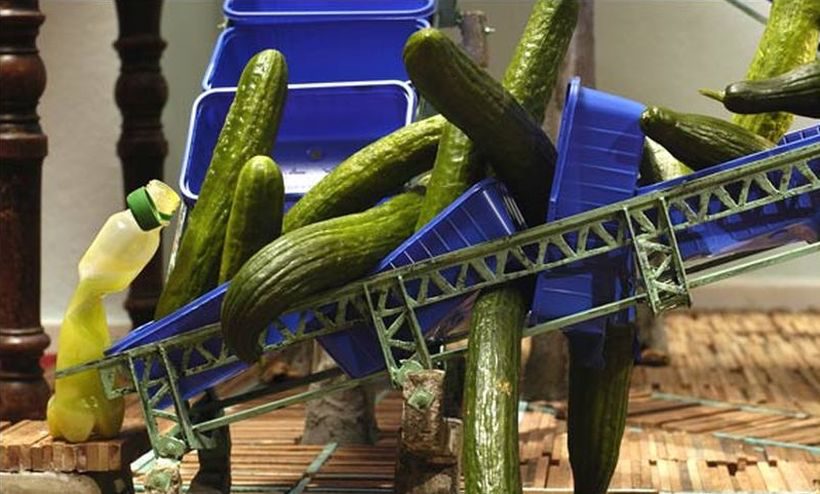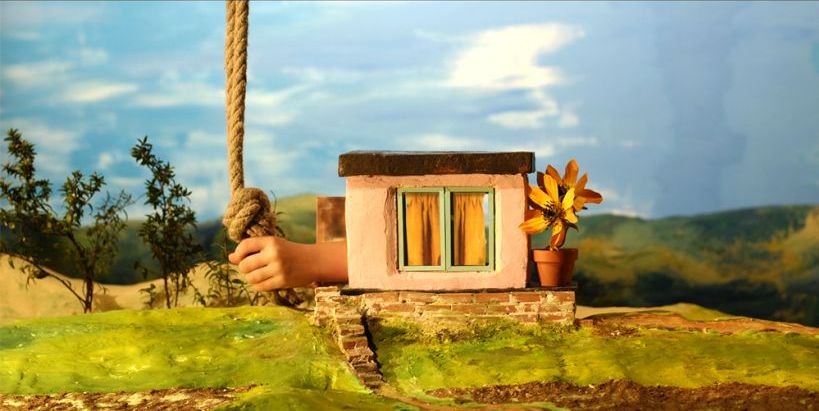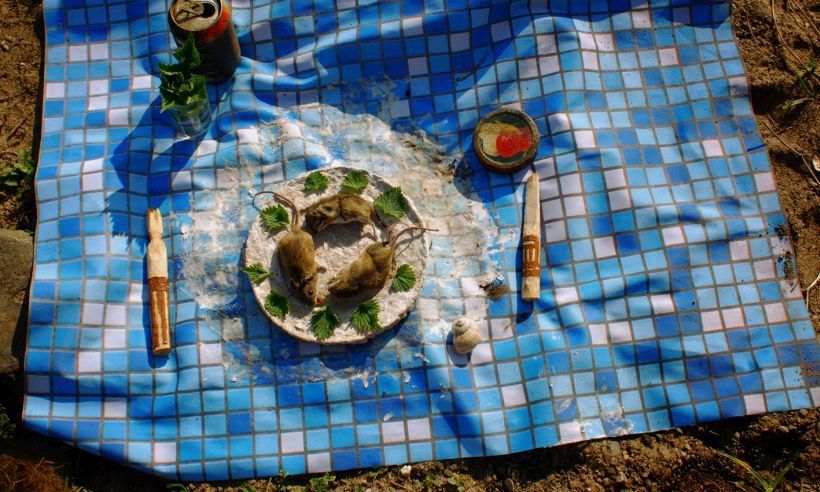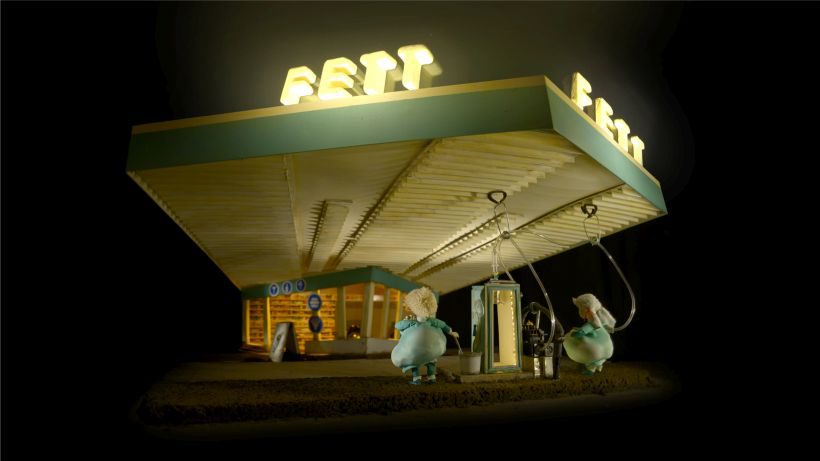
GRÜN © niky-bilder Trickfilmwerkstatt Köln
The films by Kyne Uhlig and Nikolaus Hillebrand are full of things that you would usually find in the kitchen or a closet. Gherkins march in step, spoons develop a dubious life of their own and lonely socks desperately search for their better halves. The filmmakers, who live and work together in Cologne and go by the name of “niky-Bilder”, prefer to use everyday as well as lost-and-found objects and breathe new life into them for their animated films – and that’s especially practical considering that they live right next door to their studio, making it easier to, whenever the need arises, place the contents of their domestic cupboards in the spotlight.
“We are not quite able to separate life from work”, explains Kyne Uhlig, adding: “But that’s just how we like it. I really can’t imagine working any other way.”
Not only do they use their toys and kitchen appliances in the short films, but also go as far as to include their four children. Many of their works were inspired by their children and children’s friends, such as in STROMSPAREN (Saving Energy – 2009), which is about possible ways to slow down the process of climate change by using energy resources more cleverly. Or to be more precisely: it is about kids’ various relative thoughts on the topic. For this purpose, Uhlig und Hillebrand recorded and edited the ideas of a group of five- to twelve-year-old screenwriters. In the finished film, their original voices act as the voice-over – but only once the soundtrack was completed did the filmmakers begin to consider how to bring the ideas alive with various animation techniques.

STROMSPAREN © WDR / niky-bilder Trickfilmwerkstatt Köln
After just a few scenes it becomes apparent that the children’s ideas only seem crazy or unrealistic at first glance. So although a house with technology that enables it to swivel its heated roof 180 degrees to be used as floor heating (unfortunately, as one of the young energy experts notes, the furniture would always fall over) has yet to be constructed, the utilisation of less revolving solar thermal distribution systems have long become commonplace. A similar idea is that of breeding small monsters to live in toilets to feed on the waste that human dwellers would otherwise flush into the sewerage system with lots of water and pumping power. Grownups might describe these monster toilets (depicted in the film as woollen sock monsters with friendly faces) a little less prosaically as composting toilets. But whatever you wish to call them; these are most certainly environmental-friendly ideas.
Unlike STROMSPAREN, which, like many of the niky-Bilder films was commissioned by the German television station WDR, WAS DA LEBT (Traces of Life – 2012) is an independent in-house production. Every 3-4 years, the niky animators treat themselves to a film of ‘their own’ – without a commission and without time pressure – in exchange for the artistic freedom to devote themselves to a subject they are burning to explore whilst also having the liberty to make new decisions in the midst of the process. In this almost 10-minute stop-motion epic they take us inside their home where objects lead eerie lives of their own, banding together with the family’s four children and actively throwing the adult world into turmoil, day after day. Everyone who has children (and maybe all the others too!) are without doubt familiar with the catastrophic mechanisms which turn tidy rooms into messy labyrinths and extensive cave systems in no time. In WAS DA LEBT, the filmmakers used stop-motion techniques to set their private living space in motion: breast-pumps, piles of blankets, children (even a newborn) and crazed toilet paper rolls scuttle around, transforming rooms into play dens at record speed, with wild Lego rivers flowing through them. Domestic chaos has rarely been depicted in such an aesthetically pleasing way.

WAS DA LEBT © niky-bilder Trickfilmwerkstatt Köln
All films that emerge from the niky-Bilder house of productions bear the unmistakeable imprint of passion for detail and are quite obviously made by hand. Instead of making effects in post production and simply laying them ‘over’ the images, they cleverly utilise natural phenomena (such as wafts of mist, wave movements and light reflexes) or create the effects by hand while working with plaster, wood, clay and anything else that is able to oppose the forces of gravity. The result is in conscious contrast to the bulk of many other contemporary animations. Their films have a workshop vibe. In order to ensure that the films are discernibly hand made, small imperfections are readily tolerated.
“Both of us love working with our hands, which is actually why we became animators because we love crafting and working with material. We also happen to be avid collectors and lovers of recyclables. That’s why we hoard worn-out everyday objects as well as the flotsam that washes up on our doorstep from the River Rhine. We draw inspiration from that what surrounds us, and have fun improvising or even allowing things to guide us a little.” (Kyne Uhlig)
However, both artists obviously cannot get by without the use of digital editing and postproduction. Digitalisation has not only altered but also in many ways improved their methods of working, as Nikolaus Hillebrand emphasises. Whereas once the shooting of a film had to be completed before the editing process could begin, it is now possible for both procedures to run parallel with one another, making the process considerably more flexible. Another positive aspect they both appreciate is how digital technology has allowed them to execute almost each step of the working process by themselves, meaning that the entire production practically lies in their hands. The ratio between digital and handcrafted work in the duo’s films currently stands at around 1:1 and Kyne Uhlig hopes that the ratio does not edge any closer towards the digital:
“Digital isn’t always better. I find the balance between the digital and handicraft in our films perfect at the present moment. It’s important to me that the handmade element stays relevant as the foundation of our films.”
Even if they can hardly imagine doing anything else other than animation today, the path they took was not straightforward in the least. While Uhlig originally wanted to make documentary films and studied Geography in preparation thereof, Hillebrand graduated in Architecture and subsequently worked on various projects with Hellmuth Costard and his Sun-Machine. They eventually fell for animation after travelling to Riga, Latvia with the German experimental filmmaker Hellmuth Costard shortly after the fall of the Wall to assist him during the production of his film AUFSTAND DER DINGE (1993). For weeks, Latvian stop-motion specialists were busy producing animated scenes that would then be worked into the live-action film. It was this weird film that proved to be Nikolaus Hillebrand’s and Kyne Uhlig’s initial doorway to the animation universe. Both cite further influences such as the surreal stop-motion films by the great Czech master Jan Švankmajer and the works of French all-rounder Michel Gondry. Other films they consider to be of equal importance as sources of inspiration are those that rub them up the wrong way and motivate them to tell their own stories in an entirely different fashion.
An example of how this “different storytelling” looks is demonstrated in the numerous fairytale films the couple has produced for the children’s TV series, ‘Sendung mit der Maus’ (The Show with the Mouse) since 2012. It started with VOM FISCHER UND SEINER FRAU (The Fisherman and his Wife, 2012), in which they combined live-action with stop-motion and digital animation to retell the old tale in an entirely new way. A narrator guides the viewer through the story, and while the outline is based on the Grimms’ source text, they have humorously embellished the original with modern elements. Other modernised stop-motion adaptations soon followed with DER SÜẞE BREI (The Magic Porridge Pot, 2014), BABA JAGA (Baba Yaga, 2015) and DIE PRINZESSIN AUF DER ERBSE (The Princess and the Pea, 2017).
Kyne Uhlig emphasises the importance they both feel when it comes to making films equally enjoyable for children and adults:
“The first and most decisive level is naturally aimed at children, but we always incorporate a few further layers which might not necessarily be perceived by everyone. However, even if one is only able to grasp the first level, the film will still remain comprehensible of course. But those who take a closer look will possibly discover one or two little jokes or a double entendre that we have incorporated especially.”
It is precisely this complexity that distinguishes Kyne Uhlig und Nikolaus Hillebrand’s work from others. The multifacetedness is most apparent in their independent productions such as GRÜN (Green, 2008) , which also screened at the Berlinale, or FETT (Fat, 2016). Even if FETT, just like STROMSPAREN and ZUKUNFT is based on the ideas and texts by children, the 8-minute film is by no means a film for children. Accompanied by an excellent and extremely disquieting soundtrack, this stop-motion animation takes the viewer into a strange and curious world that is nevertheless weirdly familiar because it is made of estranged everyday objects. A microcosm created with plastic bottles, old LPs and bottle tops in which everything revolves around fat: cars made of PET bottles are fuelled at filling stations with fat that has been taken from the overweight drivers themselves – the glutinous mass is extracted from their swollen bodies with a revolting gurgling sound and channelled straight into the fuel pump. In order to replenish supplies, people ‘refuel’ at chip-eating stations and are subsequently ‘milked’. This seemingly endless cycle could hardly be more obvious in its biting social critique. Then, when a new car that is able to directly refuel with the driver’s fat – without having to take a detour to the filling station – is created, it initially seems as though the breakthrough discovery has perfected the cycle. But the protagonists miscalculated the breakthrough since the cycle of gluttony, digestion, excretion and recycling can be perfected even further…

FETT © niky-bilder Trickfilmwerkstatt Köln
Rarely has the consumerist society been satirized so pointedly – and as such by an 8-minute animation based on the futuristic visions of three children. The FBW (German federal authority for evaluating and rating film and media) quite rightly conferred FETT with the label “especially worthwhile”. Indeed, even if it was not explicitly made for children, riveting discussions are sure to ensue should one choose to watch this film with older children or teens. And it is just such discussions with young people that continue to inspire Kyne Uhlig and Nikolaus Hillebrand. This is also why they started leading animation workshops for children and youth in 2004, alongside their directing work. Here, the same applies, too: digital is not always better – handicraft first: They generally leave the computer out of the working process and animation takes place in the here and now, right in front of the camera. Participants learn various animation techniques to transform their stories into images. And all the while, the niky-Bilder duo is busy gleaning new “fuel” for their next film.
Links
Filmography
1998 SCHIRMHERRSCHAFT
2000 KIRSCHFILM
2002 BACKE BACKE KUCHEN
2002 SOMMERLIEDER
2004 OKTOBERTAG
2004 EIERMALEN IM KÜHLSCHRANK
2004 NIKOLAUS-HAUS
2005 KLOTZTANZ
2007 GRÜN
2008 HALLOWEEN
2009 STROMSPAREN
2011 KINDER SEHEN IN DIE ZUKUNFT
2012 WAS DA LEBT
2012 VOM FISCHER UND SEINER FRAU
2014 DER SÜẞE BREI
2015 BABA JAGA
2016 FETT